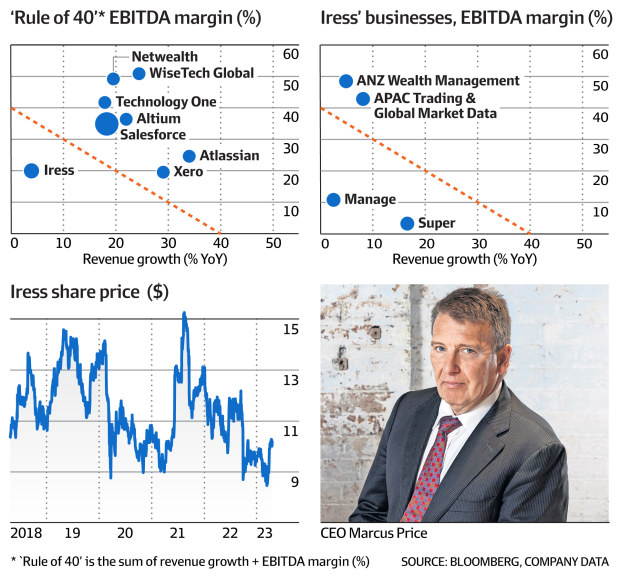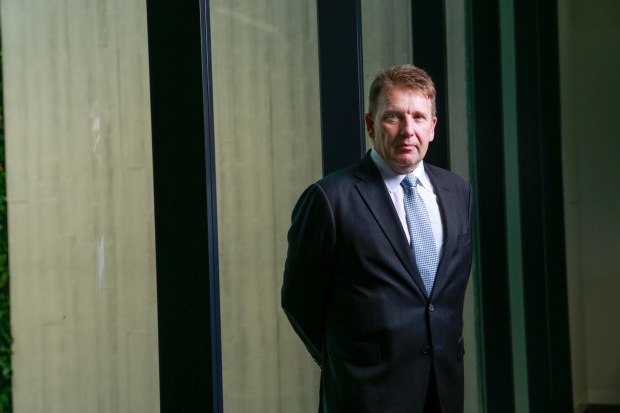Chanticleer

This one ruthless step might just transform Iress
The group’s new strategy leaves its boss, Marcus Price, with nowhere to hide.
Software group Iress Ltd’s new strategy leaves its boss, Marcus Price, with nowhere to hide.
Six months into the top job, Price and the board have pinned their futures to a clear and specific vision, which should be easily measurable for years to come.
A successful Iress will pass the “rule of 40” test, both in terms of the group and its mature business units. The rule of 40 says a company’s revenue growth plus EBITDA margin (both in percentage points) should add up to 40 or more.

It’s a commonly used metric for software-as-a-service companies and allows room to invest in fast-growing businesses, while also dictating that everything should make good money for shareholders once growth slows down.
The carrot, for Iress, is more value for shareholders. ASX-listed SaaS stars Xero, WiseTech Global, Technology One, Altium and Netwealth all pass the rule of 40 test, and the cheapest trades at 11.4 times forecast revenue and 26 times forward EBITDA.
Iress, a software company that has increased revenue every year for the past 22 years, trades at 3.5 times revenue and 16 times EBITDA.
The difference is that it is not in the rule of 40 club.
It’s simple thinking from the Iress board, headed by Webjet chairman and Kiwi tech investor Roger Sharp and CEO Price, who made his name building real estate settlements platform PEXA from the ground up.
To pull it off requires a fresh start and some ruthless decisions. Gone are the grand global growth plans and, in their place, a decision to refocus wholly on its Australian wealth, trading and markets data, and superannuation businesses.
Everything else will be divested or run for cash.
Two of the three now-core businesses – Australian wealth and trading and markets – already pass the rule of 40 test. The third (superannuation) is newer and the fastest growing of the trio.
The strategy was accompanied by 369 job cuts, worth 10 per cent of the workforce as at the end of last year. They include 230 full-time positions that are still to be chopped.
Staff found out about the pending cuts on Wednesday night, before the strategy day.

Iress CEO Marcus Price called in the consultants on arrival. Wayne Taylor
“What we’ve got here is a great Aussie software company hiding in plain sight,” Sharp says, albeit one that lost its focus on shareholder returns.
Iress always grew revenue year-on-year, but did it by allocating capital to acquisitions and chasing an offshore dream that hasn’t been able to keep up with its core Australian business (from a returns perspective).
Australian fund managers, all big users of Iress’ trading system for their day-to-day investing, watched it unfold for years, frustrated that another domestic champion was blowing capital offshore.
Price, an outsider to the wealth and financial services sector, signed on to replace long-term Iress executive Andrew Walsh last July, and took the keys in October.
He says he was the “not wedded-to-the-past guy” who could see the company had diverted from its software roots and now “looked like a pretty boring industrial company” to investors. The evidence was in the share price: Iress is up 26.3 per cent on a total return basis in the past five years, while the S&P/ASX 200 has gained 62 per cent and the ASX Information Technology index is up 61 per cent.
Lost decade
Unable to get the data he needed internally, Price called in the consultants (McKinsey) to help find out what was working and what wasn’t, and ultimately focused on revenue growth and margin in each market/product.
“We started spending money offshore, we struggled to achieve our required returns and put a lot of focus and effort into those underperforming offshore businesses,” he explains of the lost decade.
“The idea now is to get much closer to customers to reinvest and double down on our core, and then start participating with them in the growth of those industries.”
So Price, with the board’s blessing, has split everything into two buckets: core and manage for value.
The core businesses were responsible for $357 million revenue at a 30 per cent to 35 per cent EBITDA margin in 2022, while the manage businesses reported $261 million revenue at 8 per cent to 15 per cent margin.
Effective July 1, the core businesses will include its wealth management division (the Xplan software used by more than half of Australia’s financial planners), trading and markets (the trading system used by most Australian equities market participants) and superannuation, which provides back office administration for the likes of Commonwealth Superannuation Corp, ESS and GuildSuper.
Private equity thinking
The first two easily pass the rule of 40 test, and Iress expects both to increase revenue in coming years as they refocus on existing clients and products. Superannuation fails the test, but is growing quickly and building up a stable of long-life contracts that are typically sticky and most profitable later in life.
Manage for value is everything else, but most notably its UK mortgages and sourcing businesses and its local MFA and platforms arm (already slated for divestment). Analysts reckon the whole manage-for-value portfolio could go in time. JPMorgan put a $330 million “conservative” valuation on the assets.
Key to the strategy is divisional leadership and P&L responsibility for line managers.
“We’re going to manage the offshore businesses as if we were a private equity company, basically,” Price says.
“We’re using the toolkit of private equity, which might include joint ventures or carve outs or co-investment, or any number of things that we can actually adopt.”
Whatever happens, Price says he expects those offshore businesses to continue to be linked to Iress, distributing its products such as Xplan, perhaps under licence or other franchise-like structures.
Sharp was quick to say there was nothing private equity-like in its approach to the core businesses. “It’s a re-invest to improve and get close to your clients mindset,” he said.
It’s interesting to hear Iress talk about private equity thinking. The company was in talks with Swedish private equity firm EQT for about 12 months, when Sharp was new to the chairman’s seat. Iress pushed EQT hard and ended up granting due diligence on a bid worth $15.91 a share.
The talks fell over. Iress shares have not traded above $10.50 this year. The strategy reset is overdue in investors’ minds.
Analysts were quick to point out some wrinkles in the new strategy: near-term gearing will increase to as much as 2.6 times earnings (on a net debt to EBITDA basis) thanks to increased investment spend, rising interest expense and restructuring costs. Iress also snuck in a small earnings downgrade (on a business-as-usual basis).
JPMorgan’s Bob Chen said the near-term costs should be worth it. “There was enough in the strategy day to provide a clearer picture on how management will improve near-term profitability and has now created a clear delineation between profitable and non-profitable business units,” he said. Chen valued the core businesses at 20 times EBITDA or $2.44 billion.
Macquarie’s team told clients the “organisational realignment does resonate with us”.
Now it’s all about making the strategy work. If Sharp, Price and co can pull it off, the company could get its Xero/Netwealth/Altium-type valuation and get the EQT monkey off its back.
If not, then it’s the sort of clear and concise strategy that does have a lot of wriggle room.
Subscribe to gift this article
Gift 5 articles to anyone you choose each month when you subscribe.
Subscribe nowAlready a subscriber?
Introducing your Newsfeed
Follow the topics, people and companies that matter to you.
Find out moreRead More
Latest In Technology
Fetching latest articles